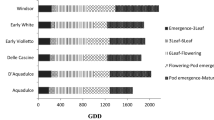Abstract
The marama bean, Tylosema esculentum, is a drought- tolerant legume native to southern Africa. Its seeds are comparable to soybeans in protein content and quality, its oil content approaches that of peanuts, and the plants might be desirable as a forage legume. Although the marama bean has great potential as an arid land crop in the United States, studies of the species are extremely limited. The current investigations have demonstrated that the plants can be grown successfully in an arid region of the United States, at least under experimental conditions, and that a healthy seed crop can be expected in about 4.5 years.
Similar content being viewed by others
Literature Cited
Biesele, M., and R. E. Murry. 1983. Alternative food plants for arid regions. Final project report, morama and other plant foods of Kalahari foragers: An applied ethnobotanical study. Center for the Study of Human Adaptation, Univ. Texas, Austin.
Bousquet, J. E. 1982. The morama bean of the Kalahari Desert as a potential food crop, with a summary of current research in Texas. Desert Pl. 3:213–215.
-. 1983. Food and cultivation potential of marama beans from the Kalahari Desert. Manuscript of presentation, symposium on sources of food from rarely used plants, AAAS meetings, Detroit, Michigan, May 26-31, 1983.
Coetzer, L. A., and J. H. Ross. 1977.Tylosema. In Ross, J. H., ed., F1. Southern Africa 16(2):61-64.
Coomber, H. E., and T. J. Coomes. 1950. Marama(Bauhinia esculenta) oil from Bechuanaland. Colon. Pl. Anim. Prod. 1(2):122–125.
Economic Plants of South Africa. 1924.Bauhinia esculenta Burch. Notes from the National Herbarium and Museum, Series 2, Dept. of Agriculture, Pretoria, South Africa, [p. 613-615.]
Miller, D. J, and A. M. Powell. 1981. The potential for morama,Tylosema esculentum, as an aridland crop for west Texas. Chihuahuan Desert Res. Inst. Contrib. 118.
National Academy of Sciences. 1979. Tropical legumes: resources for the future. National Research Council, Washington, DC.
Ripperger-Suhler, J. A., and J. B. Longenecker. 1982. Assessment of the nutritional value of morama bean. Report to the Center for the Study of Human Adaptation, on file at the Division of Graduate Nutrition, Univ. Texas, Austin.
Story, R. 1958. Some plants used by the Bushmen in obtaining food and water. Bot. Surv. South Africa Mem. 30.
Watt, J. M., and M. G. Breyer-Brandwijk. 1962. The medicinal and poisonous plants of Southern and Eastern Africa. 2nd ed. E. & S. Livingstone Ltd., Edinburgh.
Vietmeyer, N. D. 1986. Lesser-known plants of potential use in agriculture and forestry. Science 232:1379–1384.
Author information
Authors and Affiliations
Rights and permissions
About this article
Cite this article
Powell, A.M. Marama Bean (Tylosema esculentum, Fabaceae) seed crop in Texas. Econ Bot 41, 216–220 (1987). https://doi.org/10.1007/BF02858969
Received:
Accepted:
Issue Date:
DOI: https://doi.org/10.1007/BF02858969




